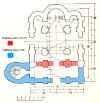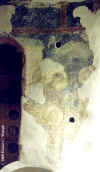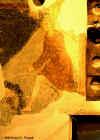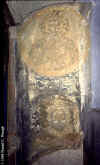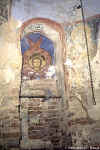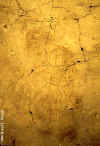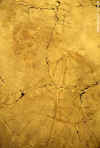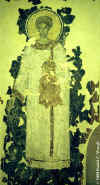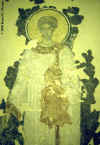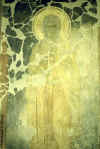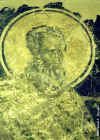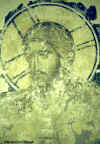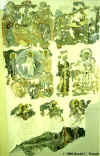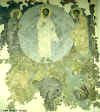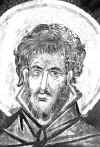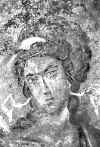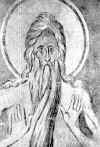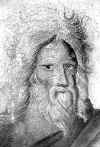Novgorod Churches and Their Frescoes
[Return to Novgorod home page.]
Here is a start on what I hope will eventually become a much more
extensive set of pages regarding medieval Novgorod architecture and the iconography of the
interior of the churches. Photographs of the frescoes are often not readily
available, although excellent publications of single churches do exist in Russian.
There is one, for example, for the Kovalevo church. Some of the images here may not
be found elsewhere. While I provide some introductory commentary, a real analysis of
this material must wait for another time.
The two sets of images here are: 1. The Church of the Nativity
of Our Lady in the Monastery of St. Anthony; 2. The Church of the Transfiguration of
the Savior in the village of Kovalevo. Others which I shall eventually add include
the Church of the TRansfiguration of the Savior on Nereditsa and the Church of the
Transfiguration on Il'in Street. All images are thumbnailed; click to bring up the
enlargement.
The Church of the Nativity of Our Lady in the Monastery of St. Anthony
 The Monastery of St. Anthony, shown on the left side of a
seventeenth-century engraving from the famous travel account by Adam Olearius, is located
north of the center of Novgorod on the East side of the Volkhov River .
According to tradition, Anthony was from Rome (hence he is called
"Rimlianin"). We know about him primarily from a Vita written late in the
fifteenth century and a sixteenth-century sermon praising him, that is, from texts written
centuries after he came to Novgorod. His Vita relates how he fled persecution of the
Orthodox by the Roman Catholic Church. Caught in a storm while on his ship, he was
saved by the miraculous appearance of a stone, on which he could stand, and when the
weather cleared, he discovered he was in Novgorod, at the location where he then founded
his monastery early in the twelfth century. He is mentioned in the Novgorod
chronicles under the years 1117 and 1147. The miraculous stone was in fact later
transported into the main church of the monastery, the Church of the Nativity, where it
was revered for its miraculous powers--a good example of popular Orthodox belief which in
many different places both in Russia and in the Orthodox East included among holy relics
stones considered to possess such powers. Miracles connected with the stone were
recorded in the sixteenth and seventeenth centuries; the author of one of the most
interesting accounts about Muscovy, Deacon Paul of Aleppo, who visited Novgorod in 1655,
mentioned the cult of Anthony and the miraculous stone.
The Monastery of St. Anthony, shown on the left side of a
seventeenth-century engraving from the famous travel account by Adam Olearius, is located
north of the center of Novgorod on the East side of the Volkhov River .
According to tradition, Anthony was from Rome (hence he is called
"Rimlianin"). We know about him primarily from a Vita written late in the
fifteenth century and a sixteenth-century sermon praising him, that is, from texts written
centuries after he came to Novgorod. His Vita relates how he fled persecution of the
Orthodox by the Roman Catholic Church. Caught in a storm while on his ship, he was
saved by the miraculous appearance of a stone, on which he could stand, and when the
weather cleared, he discovered he was in Novgorod, at the location where he then founded
his monastery early in the twelfth century. He is mentioned in the Novgorod
chronicles under the years 1117 and 1147. The miraculous stone was in fact later
transported into the main church of the monastery, the Church of the Nativity, where it
was revered for its miraculous powers--a good example of popular Orthodox belief which in
many different places both in Russia and in the Orthodox East included among holy relics
stones considered to possess such powers. Miracles connected with the stone were
recorded in the sixteenth and seventeenth centuries; the author of one of the most
interesting accounts about Muscovy, Deacon Paul of Aleppo, who visited Novgorod in 1655,
mentioned the cult of Anthony and the miraculous stone.
 With the exception of the main church, the original buildings of the
monastery have not survived. On the left are the 19th-century gate and the refectory
Church of the presentation, built in the sixteenth century. At one time the
monastery housed the theological academy created as a result of the early
eighteenth-century church reform under Peter the Great; one of the academy buildings is
extant. Here we will concentrate on the twelfth-century Church of the Nativity of
Our Lady, a building which is arguably very important in the history of early Russian
architecture and which contains very interesting remnants of its original fresco
decoration.
With the exception of the main church, the original buildings of the
monastery have not survived. On the left are the 19th-century gate and the refectory
Church of the presentation, built in the sixteenth century. At one time the
monastery housed the theological academy created as a result of the early
eighteenth-century church reform under Peter the Great; one of the academy buildings is
extant. Here we will concentrate on the twelfth-century Church of the Nativity of
Our Lady, a building which is arguably very important in the history of early Russian
architecture and which contains very interesting remnants of its original fresco
decoration.
 The Church of the Nativity, begun in 1117, is one of the
earliest still largely intact churches from medieval Russia. At one time, it was
thought that the structure followed the six-pillar plan common to early Orthodox churches
in the south and found in the contemporaneous Novgorod churches of St. Nicholas and St.
George (in the Iur'ev Monastery--right). Studies done as recently as two decades ago
have shown that in fact the original building had a single cupola (now it has three) and
an approximately square floor plan with only four pillars. This much was completed
by 1119, and some time after the interior had been painted in fresco in 1125, a narthex,
stairwell and balcony were added to the west end of the church, the basic construction
being completed probably prior to 1150. The current state of the building and a
floor plan delineating the addition are here:
The Church of the Nativity, begun in 1117, is one of the
earliest still largely intact churches from medieval Russia. At one time, it was
thought that the structure followed the six-pillar plan common to early Orthodox churches
in the south and found in the contemporaneous Novgorod churches of St. Nicholas and St.
George (in the Iur'ev Monastery--right). Studies done as recently as two decades ago
have shown that in fact the original building had a single cupola (now it has three) and
an approximately square floor plan with only four pillars. This much was completed
by 1119, and some time after the interior had been painted in fresco in 1125, a narthex,
stairwell and balcony were added to the west end of the church, the basic construction
being completed probably prior to 1150. The current state of the building and a
floor plan delineating the addition are here:
The importance of this relatively recent discovery about the construction
of the church lies in the fact that the three-apse, single-coupola, four-pillar church
became the norm in many parts of Russia in subsequent centuries. The argument now is
made that this form may have originated in Novgorod, possibly even with the Church of the
Nativity, and from there spread to other regions.
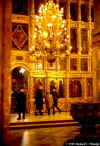 The interior of this early church also provides interesting evidence
regarding iconographic programs and displays. Today the icon screen, which separates
the eastern (altar sanctuary) end of the church from the rest, as an obligatory feature of
Orthodox churches (see photo, right). However, icon screens developed over some
time, perhaps reaching their full height and complexity only in the early fifteenth
century in Russia. In earlier centuries, the main iconographic program of a masonry
church would be displayed in the mosaics or frescoes on its walls. Individual icons
of importance might be attached to the forward pillars, placed on stands, or possibly hung
from a crossing beam in the center between the forward pillars. It is likely that
the first "icon screens" were drapes which could be pulled to close off the
sanctuary and might display a holy image.
The interior of this early church also provides interesting evidence
regarding iconographic programs and displays. Today the icon screen, which separates
the eastern (altar sanctuary) end of the church from the rest, as an obligatory feature of
Orthodox churches (see photo, right). However, icon screens developed over some
time, perhaps reaching their full height and complexity only in the early fifteenth
century in Russia. In earlier centuries, the main iconographic program of a masonry
church would be displayed in the mosaics or frescoes on its walls. Individual icons
of importance might be attached to the forward pillars, placed on stands, or possibly hung
from a crossing beam in the center between the forward pillars. It is likely that
the first "icon screens" were drapes which could be pulled to close off the
sanctuary and might display a holy image.
The Church of the Nativity dates to the period prior to the emergence of
the icon screen as we know it today. As with all early Russian churches, its
original interior was much changed over the centuries. Frescoes generally became
dark or decayed from moisture; so they were painted over, the idea being that the holy
images
 were simply being renewed, not that the sanctity of the originals or the
"originality" of the early artists' work was being violated. Originality
was, after all, not a criterion in the Church art, which was the product of divinely
inspired labor. In the case of the frescoes of interest here, when the re-plastering
and re-painting were done, holes were made in the original surface in order to get the new
layer to adhere. Hence the blotchy appearance of the early frescoes when uncovered.
In the church today, one can see both some of the original frescoes and what
remains of the nineteenth century ones (especially in the cupola, left). The later
re-plastering included adding stucco decoration, which is visible in some of the
photographs. Apart from the re-painting, an icon screen was built, in the process
concealing some of the earlier frescoes and evidence about the original construction.
In the my photos taken in 1968, the remants of the blue wood of the icon screen can
be seen (right); now it has been removed entirely.
were simply being renewed, not that the sanctity of the originals or the
"originality" of the early artists' work was being violated. Originality
was, after all, not a criterion in the Church art, which was the product of divinely
inspired labor. In the case of the frescoes of interest here, when the re-plastering
and re-painting were done, holes were made in the original surface in order to get the new
layer to adhere. Hence the blotchy appearance of the early frescoes when uncovered.
In the church today, one can see both some of the original frescoes and what
remains of the nineteenth century ones (especially in the cupola, left). The later
re-plastering included adding stucco decoration, which is visible in some of the
photographs. Apart from the re-painting, an icon screen was built, in the process
concealing some of the earlier frescoes and evidence about the original construction.
In the my photos taken in 1968, the remants of the blue wood of the icon screen can
be seen (right); now it has been removed entirely.
The removal of the icon screen made it possible to establish that probably
in the original church a single beam crossed the front pillars approximately "one
storey" above the ground. From it would have been hung a curtain, but on the
front of the pillars just above and below it very sizeable icons were displayed.
There may or may not have been a group of small icons suspended from the middle section of
the beam. I have not attempted here to identify all the images remaining from the
original frescoes (in fact, that may not be possible), but will comment on selected
aspects of the iconography. We start by looking up from below toward the front
pillars and main apse of the church (the view omits the "first storey"), then
look at the images of the archangel Gabriel and Mary on the respective pillars.
The depictions of Gabriel and Mary are in fact a single iconographic image--the
Annunciation, one of the important events in the liturgical calendar portraying the moment
when the archangel appears to Mary and informs her she is to give birth to Jesus.
The early Russian churches adopted from Byzantium the practice of displaying the
Annunciation as it is here--flanking the opening to the Sanctuary. Since Byzantine
artistic norms after the iconoclast controversy forbade three-dimensional portayals of
holy figures, the Byzantine artists devised a way to combine the two dimensionality of
individual paintings with the three-dimensional space created by the architecture.
Thus the Annunciation "takes place" in three dimensional space and in a sense
invites the believer's gaze into the main apse, where the key elements of the Christian
theology would be represented in additional images and in the liturgy itself. Such
a depiction of the Annunciation likely would be found even if a church were not dedicated
to the Nativity of Our Lady, as is the case here. Additional fesccoes in the apse
area seem to have included scenes specific to the life of Mary as recorded in an
apocryphal Gospel text popular in Byzantium.
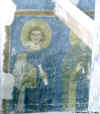 Below the Annunciation are four half-figure saints (that probably was the
way they were originally portrayed, leaving space below for a large icon to be placed on
either pillar). The images are those of SS. Cyrus, John, Florus and Laurus, who
were known for their vows of poverty. The leftmost of these images is on the left
(unfortunately somewhat blurred).
Below the Annunciation are four half-figure saints (that probably was the
way they were originally portrayed, leaving space below for a large icon to be placed on
either pillar). The images are those of SS. Cyrus, John, Florus and Laurus, who
were known for their vows of poverty. The leftmost of these images is on the left
(unfortunately somewhat blurred).
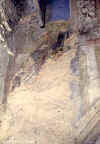
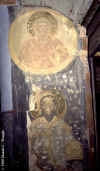 The remaining early frescoes in the main part of the church are in the
lower altar and apse area. Among the themes were the Presentation in the Temple,
the Beheading of John the Baptist and the presentation of his head to Herod, the Adoration
of the Magi (detail, left) and the Dormition. Of particular interest are the images
of Moses (lower on right) and Aaron on the pillars flanking the central opening to the
altar, emphasizing the connection of the altar with the Old Testament Temple and Ark of
the Covenant. As one can see from these images, the state of preservation is poor;
in the case of the seraph in the niche, the painting is of much later date.
The remaining early frescoes in the main part of the church are in the
lower altar and apse area. Among the themes were the Presentation in the Temple,
the Beheading of John the Baptist and the presentation of his head to Herod, the Adoration
of the Magi (detail, left) and the Dormition. Of particular interest are the images
of Moses (lower on right) and Aaron on the pillars flanking the central opening to the
altar, emphasizing the connection of the altar with the Old Testament Temple and Ark of
the Covenant. As one can see from these images, the state of preservation is poor;
in the case of the seraph in the niche, the painting is of much later date.
The style of these early frescoes is a reminder of the international contacts of
medieval Rus and Novgorod in particular. V. N. Lazarev, a noted expert on early
Russian and Byzantine painting notes their "un-Byzantine" character and connects
them with some of the contemporary Romanesque art in the West. There are numerous
other examples of the art of the West making its way to Novgorod, of course not all of
them attesting to the presence in the city of western artists. In the given
instance, Lazarev leaves open the possibility that western artists contributed to the
decoration of the main church in a monastery founded by a "Roman."
Among the interesting discoveries in the restorations of recent years have been
frescoes in the stairwell (below). Some time scholars discovered an image that
appears to be the Virgin Mary in a nimbus, holding what might have been a model of the
church, and adjoining that image to its right is the figure of a man inclined toward the
nimbus. This has been interpreted as possibly an image of the architect, presenting
his work to Mary for her blessing, although it is also possible that here we have simply a
novgorodian praying to an image of the Virgin of the Sign. The name "Foma"
is painted inside the nimbus, and letters have been scratched above the man's head.
Only recently, in the summer of 2000, another fresco was discovered in the
stairwell--an image of a lion. Lest one jump to the conclusion this is an example of
secular art in the church (not impossible, of course), it is worth remembering that carved
lions abound on the churches of the Vladimir area and tend to be interpreted in the
Christian iconography as having the power to ward off evil.
The Frescoes of the Church of the Transfiguration
of the Savior in Kovalevo.
 The small church in Kovalevo, located on the Volkhovets River, was
built at the behest of a Novgorod boyar Ontsifor Zhabin in 1345; its fresco decoration in
1380 was paid for by Afanasii Stepanovich and his wife Maria. The frescoes were
relatively well preserved until World War II, when the church was destroyed. In them
Lazarev again sees evidence of non-Russian influences both thematically and stylistically,
either as a result of copying foreign (most likely Soth Slavic) models or the work of
foreign artists. It is worth remembering that only two years before Theophanes the
Greek had painted the Church of the Transfiguration on Il'in Street; the Turkish advance
through the Balkans sent a wave of "second South Slavic" influence into the
Russian principalities. One of the images (left) is that of a pillar saint, a
The small church in Kovalevo, located on the Volkhovets River, was
built at the behest of a Novgorod boyar Ontsifor Zhabin in 1345; its fresco decoration in
1380 was paid for by Afanasii Stepanovich and his wife Maria. The frescoes were
relatively well preserved until World War II, when the church was destroyed. In them
Lazarev again sees evidence of non-Russian influences both thematically and stylistically,
either as a result of copying foreign (most likely Soth Slavic) models or the work of
foreign artists. It is worth remembering that only two years before Theophanes the
Greek had painted the Church of the Transfiguration on Il'in Street; the Turkish advance
through the Balkans sent a wave of "second South Slavic" influence into the
Russian principalities. One of the images (left) is that of a pillar saint, a 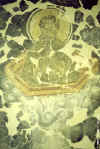
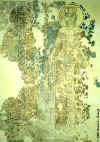 whole series of which were included by Theophanes in the Church of the
Transfiguration. The renewed interest in these early ascetic church fathers in the
fourteenth century connects with the so-called Hesychast movement, which was popular,
among other places, in the Byzantine monastic center of Mt. Athos. Lazarev
hypothesizes that the artists of Kovalevo may have come from Athos. Another image of
some interest is the depiction (right) of SS. Constantine and Elena (that is, Emperor
Constantine the Great, founder of the Christian city of Constaintinople, and his mother,
who was closely connected with patronage in the Holy Land and the recovery of fragments of
the True Cross). They were among the most prominent "forerunners" of the
rulers in medieval Serbia and were often depicted in connection with the iconographic
genealogies of the Serbian kings. One other feature of the iconographiy in the
church is worth noting The tendency seems to have been to portray the saints largely
as separate images rather than in compositions that were thematically linked to one
another, as was often the case in earlier sets of frescoes (and in the work of
Theophanes). Kovalevo's art is an indication of the direction in which Novgorodian
monumental art was headed by the late fourteenth century, where the tendency was for the
artists increasingly to reproduce individual icons at the expense of monumentality and
thematic unity.
whole series of which were included by Theophanes in the Church of the
Transfiguration. The renewed interest in these early ascetic church fathers in the
fourteenth century connects with the so-called Hesychast movement, which was popular,
among other places, in the Byzantine monastic center of Mt. Athos. Lazarev
hypothesizes that the artists of Kovalevo may have come from Athos. Another image of
some interest is the depiction (right) of SS. Constantine and Elena (that is, Emperor
Constantine the Great, founder of the Christian city of Constaintinople, and his mother,
who was closely connected with patronage in the Holy Land and the recovery of fragments of
the True Cross). They were among the most prominent "forerunners" of the
rulers in medieval Serbia and were often depicted in connection with the iconographic
genealogies of the Serbian kings. One other feature of the iconographiy in the
church is worth noting The tendency seems to have been to portray the saints largely
as separate images rather than in compositions that were thematically linked to one
another, as was often the case in earlier sets of frescoes (and in the work of
Theophanes). Kovalevo's art is an indication of the direction in which Novgorodian
monumental art was headed by the late fourteenth century, where the tendency was for the
artists increasingly to reproduce individual icons at the expense of monumentality and
thematic unity.
The images shown here in color are the pieced-together originals (and in
the last three cases, reproductions made from them), the culmination of thousands of hours
of painstaking work on the fragments left after the destruction of the church. The
black and white photos are ones taken before the War. The lighting conditions when I
took the color slides were not ideal, nor was my film fast enough; so the images are not
always quite as sharp as one would like and there tends to be a color shift reflecting the
greenish flourescent lighting..
References:
- Viktor Lazarev, Old Russian Murals and Mosaics (London: Phaidon, 1966).
- V. M. Lazarev, Iskusstvo Novgoroda (Moscow-Leningrad: Iskusstvo, 1947).
- N. A. Makarov, "Kamen' Antoniia Rimlianina," Novgorodskii istoricheskii
sbornik, 2(12) (1984), pp. 203-210.
- V. D. Sarab'ianov, "Novgorodskaia altarnaia pregrada domongol'skogo perioda,"
Ikonostas: Proiskhozhdenie--razvitie--simvolika. Ed. A. M. Lidov (Moscow:
Progress-Traditisiia, 2000), pp. 312-359.
- G. M. Shtender, V. M. Kovaleva, "O formirovanii drevnego arkhitekturnogo oblika
sobora Antonieva monastyria v Novgorode," Kratkie soobshcheniia Instituta
arkheologii, No. 171 (1982), pp. 54-60.
Return to Novgorod home page.
© 2000 Daniel C. Waugh. Last revised October 29, 2000.
 The Monastery of St. Anthony, shown on the left side of a
seventeenth-century engraving from the famous travel account by Adam Olearius, is located
north of the center of Novgorod on the East side of the Volkhov River .
According to tradition, Anthony was from Rome (hence he is called
"Rimlianin"). We know about him primarily from a Vita written late in the
fifteenth century and a sixteenth-century sermon praising him, that is, from texts written
centuries after he came to Novgorod. His Vita relates how he fled persecution of the
Orthodox by the Roman Catholic Church. Caught in a storm while on his ship, he was
saved by the miraculous appearance of a stone, on which he could stand, and when the
weather cleared, he discovered he was in Novgorod, at the location where he then founded
his monastery early in the twelfth century. He is mentioned in the Novgorod
chronicles under the years 1117 and 1147. The miraculous stone was in fact later
transported into the main church of the monastery, the Church of the Nativity, where it
was revered for its miraculous powers--a good example of popular Orthodox belief which in
many different places both in Russia and in the Orthodox East included among holy relics
stones considered to possess such powers. Miracles connected with the stone were
recorded in the sixteenth and seventeenth centuries; the author of one of the most
interesting accounts about Muscovy, Deacon Paul of Aleppo, who visited Novgorod in 1655,
mentioned the cult of Anthony and the miraculous stone.
The Monastery of St. Anthony, shown on the left side of a
seventeenth-century engraving from the famous travel account by Adam Olearius, is located
north of the center of Novgorod on the East side of the Volkhov River .
According to tradition, Anthony was from Rome (hence he is called
"Rimlianin"). We know about him primarily from a Vita written late in the
fifteenth century and a sixteenth-century sermon praising him, that is, from texts written
centuries after he came to Novgorod. His Vita relates how he fled persecution of the
Orthodox by the Roman Catholic Church. Caught in a storm while on his ship, he was
saved by the miraculous appearance of a stone, on which he could stand, and when the
weather cleared, he discovered he was in Novgorod, at the location where he then founded
his monastery early in the twelfth century. He is mentioned in the Novgorod
chronicles under the years 1117 and 1147. The miraculous stone was in fact later
transported into the main church of the monastery, the Church of the Nativity, where it
was revered for its miraculous powers--a good example of popular Orthodox belief which in
many different places both in Russia and in the Orthodox East included among holy relics
stones considered to possess such powers. Miracles connected with the stone were
recorded in the sixteenth and seventeenth centuries; the author of one of the most
interesting accounts about Muscovy, Deacon Paul of Aleppo, who visited Novgorod in 1655,
mentioned the cult of Anthony and the miraculous stone.




